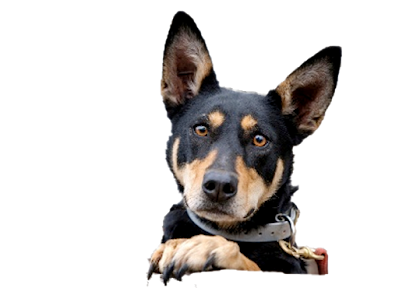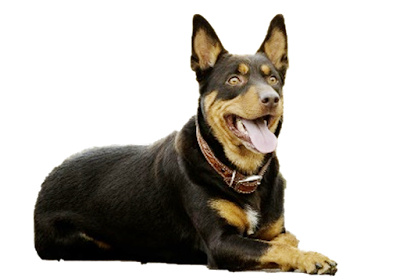Australian Kelpie
History
The breed of dog Australian Kelpie came from Australia, sorry for the obviousness and tautology. This happened when in the mid-19th century, black collies were introduced to the continent, which crossed with various dogs, and, according to some reports, even with the wild dog Dingo, which is also evidenced by some external similarities (although studies were carried out in 2019 genomes that established that there were no wild dingoes in the genus).
What came out of these crosses exceeded all the breeders' expectations and they needed a dog that could participate in cattle grazing, moreover, in the conditions of the Australian hot climate. Actually, it cannot be said that professional breeders were engaged in breeding the breed. This statement is also supported by the fact that the first individual (female) was sold in 1872 by a Scottish named George Robertson to Jack Gleason. And the name of the dog was Kelpie, which later became the name for the whole breed.
Kelpie is the name for the spirit of water from Scottish mythology. As you know, both of these people were settlers. A dog named Kelpie already did not resemble traditional black collies, and later changed even more as a result of crossbreeding, which was obviously free and little controlled. Although, targeted crossbreeding also took place.
One way or another, over time, a breed standard emerged that possessed a huge amount of energy, could withstand the harsh climatic conditions of Australia, and stay in the sun for an arbitrarily long time, with outstanding endurance.
In the future, the Kelpie breed became popular far beyond Australia. For example, in the USA these dogs are very appreciated in the hot States for their outstanding congenital qualities of a shepherd, and in Sweden, they are used for mine rescue operations. Now there are 2 varieties of Kelpie - exhibition work. The former are bred with an emphasis on appearance for appearances at exhibitions, and the latter is used for grazing. These dogs are also called the Australian Shepherd.
Breed characteristics
· Popularity 09/10
· Training 07/10
· The size 07/10
· Mind 08/10
· Security 10/10
· Relationship with children 10/10
· Agility 08/10
· Shedding 07/10
Breed Information
| The country | Australia |
| Life span | 10-13 years old |
| Height | Males: 46-51 cm Bitches: 43-48 cm |
| Weight | Males: 14-20 kg Bitches: 14-20 kg |
| Longwool | short |
| Color | black, tan, black, tan, chocolate |
| Group | for children, for protection |
Description
Kelpies are medium-sized dogs with pointed ears and a wedge-shaped muzzle. The chest is high, the physique is muscular, the legs are of medium length, and the tail does not stop.
Personality
The Kelpie breed dog has a soft and kind character, perfectly suits as a reliable and loyal friend with whom you can go even to the ends of the world. Their endurance is what they are famous for; they can eat or sleep all day, be on their feet, and at the same time do their job perfectly. Whether it is cattle guarding, traveling together, guarding the courtyard of a private house - kelpie everywhere shows itself in the best way.
This is really a friend of man in every sense of the word. They have an excellent sense of smell, excellent hearing, they have specific skills of a shepherd inherent exclusively to this breed. Developed intelligence allows you to perfectly understand not only the speech of the owner but also his psycho-emotional state, provide support in difficult times and remember commands. Very independent and independent, but not stubborn.
Children are well treated with care. They love to play and need constant daily activity, including mental. Since the Kelpie breed was originally designed for intensive activity, in the conditions of a city apartment, the owner will have to seriously take care of this issue. An ideal place for their maintenance is, of course, a private house with its own courtyard.
By the way, the dog can spend the whole day without the presence of the owner, completely without suffering from loneliness. But, if you do not provide your pet with the proper level of activity, and leave it for the whole day in the apartment, you can be sure that a full mess will await you upon arrival. After all, energy needs to be put somewhere. Also, the animal needs socialization and upbringing, as it can cast a voice in case of any irritants - strangers, loud noise in the yard, etc.
Training
The Kelpie dog breed genetically has excellent abilities to protect the territory, and it doesn’t even need to be trained. Another question is that they need to be trained in commands, proper behavior, and obedience because by their nature they are quite independent dogs. In addition - with a huge supply of energy.
To teach a pet to restrain himself, you need to do this constantly, over time. Training can begin from 5-6 months. It is important to limit the overabundance of reactions to stimuli so that the dog learns not to respond to the slightest rustling by barking, but watches carefully what is happening, “turning on” with real danger.
The independence of the kelpie must be respected - do not suppress the pet, praise him for his success, and respect him. These are very smart dogs - they understand everything, even if they try to convince you otherwise. Therefore, they remember commands easily, understand what you want from them. Justice, patience, and kindness - this is what makes a dog respect you and not only execute commands but also listen to you as an authority.
Care
With regard to grooming, the breed of Kelpie dogs is quite unpretentious, needs to be combed weekly and more. Some individuals have undercoats and molts. Be sure to keep your ears clean, remove deposits in your eyes daily, and bathe your pet once or twice a week.
Common diseases
The Kelpie dog breed is generally in good health, but the following problems can sometimes occur:
- hip dysplasia;
- cryptorchidism;
- progressive retinal atrophy;
- Collie eye anomaly
- Cerebellar abiotrophy.




.jpg)
.jpg)
0 Comments